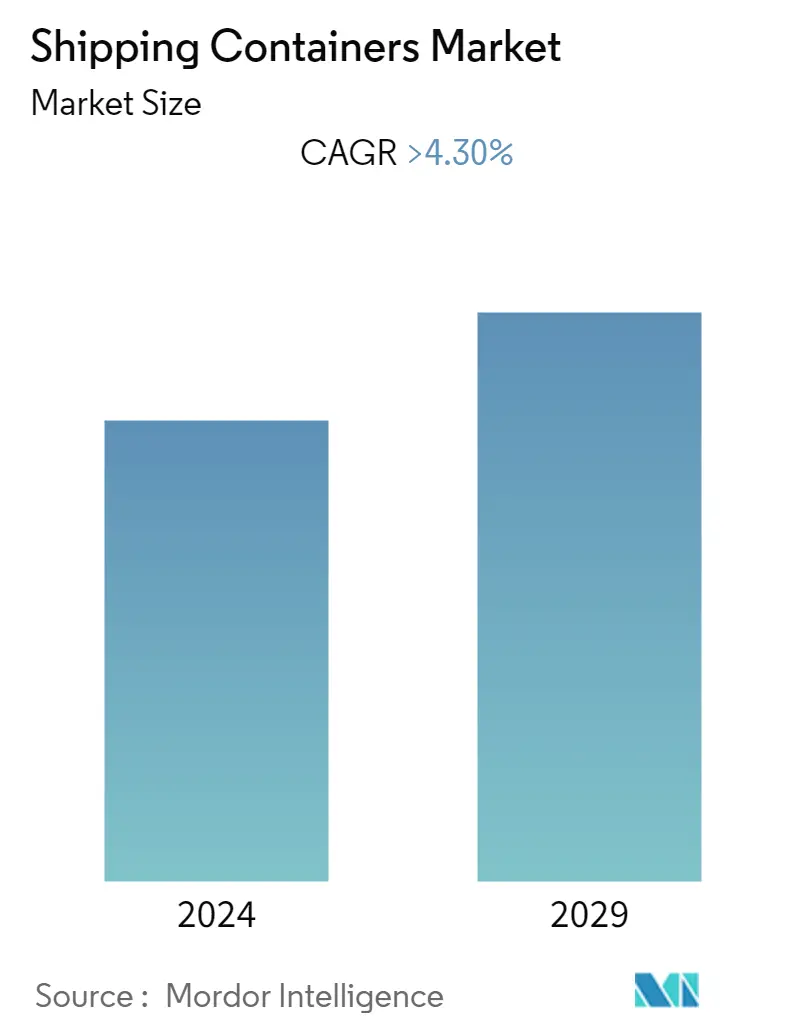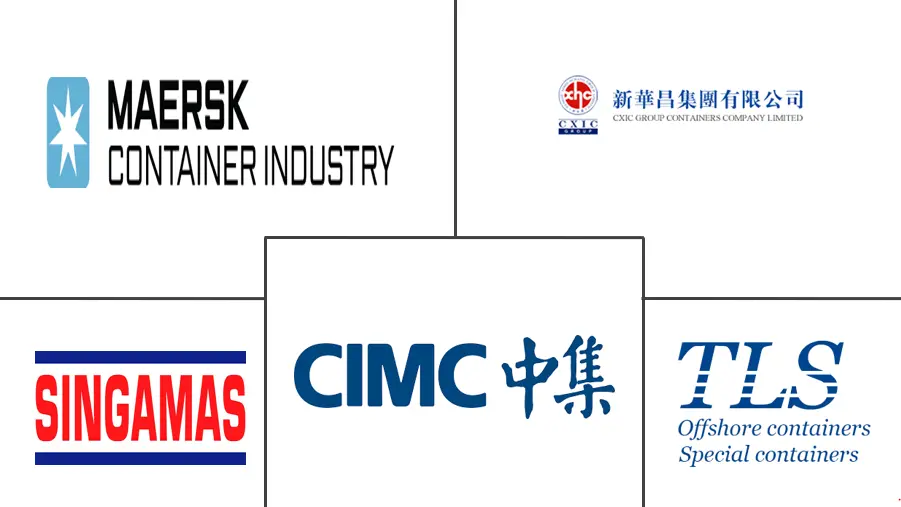Market Size of Shipping Containers Industry

| Study Period | 2020 - 2029 |
| Base Year For Estimation | 2023 |
| CAGR | > 4.30 % |
| Fastest Growing Market | Asia Pacific |
| Largest Market | Asia Pacific |
| Market Concentration | Medium |
Major Players
*Disclaimer: Major Players sorted in no particular order |
Shipping Container Market Analysis
The size of Shipping Containers market is USD 9.25 billion in the current year and is anticipated to register a CAGR of over 4% during the forecast period.
- As per reports, with the pandemic's reduction, the shipping environment should become more steady than during 2019-2021. It is anticipated that by post-pandemic, international container exports will increase by 2-3%. This is owing to the delayed revival of the maritime shipping sector and the backlogs from previous year. Additionally, it is anticipated that port congestion will return to normal in the upcoming period.
- Although maritime freight costs have dropped recently, they are still almost ten times more than before the pandemic. According to experts, the demand and supply balance in the container market will remain constant through at least the middle of 2022. Additionally, a 30% reduction in container shipping costs is anticipated over the next few months.
- Purchasing new ships is the simplest option for shipping corporations to address the space problem. For fleet expansion, shipping firms invest in new and used boats. This is a big move to address the threats from the competition and the issues facing the sector.
- For example, CMA CGM has strengthened its position in the Baltic region by purchasing ten ice-breaking cargo ships. Shipping companies like Maersk and CMA CGM are growing their fleets and purchasing aircraft fleets. The Mediterranean Shipping Company has entered the cruise ship business after purchasing 12 new ships.
Shipping Container Industry Segmentation
Shipping containers are used to transport and carriage goods without the need for unloading and reloading at intermediate points. These containers facilitate the transport of goods via land- and sea-borne transportation involving ships, rails, and trucks. A complete background analysis of the Shipping Containers Market, including the assessment of the economy and contribution of sectors in the economy, market overview, market size estimation for critical segments, emerging trends in the market segments, market dynamics, and geographical trends, and COVID-19 impact is included in the report.
The Shipping Containers Market is Segmented by Size (Small Container (20 Feet), Large Container (40 Feet), and High Cube Container), Type (Dry Storage Container, Refrigerated Container, and Tank Container), and Geography (North America, Europe, Asia-Pacific, Middle East and Africa, and Latin America). The report offers market size and forecasts in values (USD billion) for all the above segments.
| By Size | |
| Small Container (20 Feet) | |
| Large Container (40 Feet) | |
| High Cube Container |
| By Type | |
| Dry Storage Container | |
| Refrigerated Container | |
| Tank Container |
| By Geography | ||||||
| ||||||
| ||||||
| ||||||
| ||||||
|
Shipping Containers Market Size Summary
The shipping container market is poised for steady growth, driven by the anticipated stabilization of the shipping environment post-pandemic. As international container exports are expected to rise, the market is set to experience a consistent demand-supply balance. Despite recent reductions in maritime freight costs, they remain significantly higher than pre-pandemic levels, prompting shipping companies to invest in fleet expansion through the acquisition of new and used vessels. This strategic move aims to address competitive pressures and sector challenges, with major players like CMA CGM, Maersk, and the Mediterranean Shipping Company actively enhancing their fleets. The market is characterized by a few dominant players, with China International Marine Containers, Dong Fang International Container, and Maersk Container Industry holding substantial market shares. Digitalization efforts are underway to boost freight volumes amidst ongoing market challenges.
Global trade dynamics have shown resilience, with record levels achieved in 2021, although growth has been uneven across regions and sectors. Geopolitical factors, such as regional trade agreements in Africa and the Asia-Pacific, are influencing global trade patterns. The economic recovery from the pandemic has led to erratic demand swings, stressing supply chains and causing unprecedented logistical disruptions. The dry bulk sector, including biomass and sea dredging aggregates, has seen significant growth, reflecting broader economic trends. The market's consolidation is evident, with major companies dominating the landscape, although regulatory challenges have impacted potential mergers, such as the abandoned plan between China International Marine Containers and Maersk Container Industry. Additionally, new entrants like Mazagon Dock Shipbuilders are expanding into container manufacturing, responding to local production demands in regions like India.
Shipping Containers Market Size - Table of Contents
-
1. MARKET INSIGHTS DYNAMICS
-
1.1 Market Overview
-
1.2 Market Dynamics
-
1.2.1 Market Drivers
-
1.2.2 Market Restraints
-
1.2.3 Market Opportunities
-
-
1.3 Value Chain / Supply Chain Analysis
-
1.4 Industry Attractiveness - Porter's Five Forces Analysis
-
1.4.1 Threat of New Entrants
-
1.4.2 Bargaining Power of Buyers/Consumers
-
1.4.3 Bargaining Power of Suppliers
-
1.4.4 Threat of Substitute Products
-
1.4.5 Intensity of Competitive Rivalry
-
-
1.5 Technological Advancements
-
1.6 Spotlight on the Emergence of Intermodal Transport and Rail
-
1.7 Effect of Freight Rates on the Container Industry
-
1.8 Insights on Global Container Leasing Market
-
1.9 Pricing Analysis - Different Type of Containers
-
1.10 Impact of COVID-19 on the market
-
-
2. MARKET SEGMENTATION
-
2.1 By Size
-
2.1.1 Small Container (20 Feet)
-
2.1.2 Large Container (40 Feet)
-
2.1.3 High Cube Container
-
-
2.2 By Type
-
2.2.1 Dry Storage Container
-
2.2.2 Refrigerated Container
-
2.2.3 Tank Container
-
-
2.3 By Geography
-
2.3.1 North America
-
2.3.1.1 United States
-
2.3.1.2 Canada
-
-
2.3.2 Europe
-
2.3.2.1 Germany
-
2.3.2.2 United Kingdom
-
2.3.2.3 France
-
2.3.2.4 Rest of Europe
-
-
2.3.3 Asia-Pacific
-
2.3.3.1 China
-
2.3.3.2 Japan
-
2.3.3.3 India
-
2.3.3.4 Rest of Asia-Pacific
-
-
2.3.4 Middle East and Africa
-
2.3.4.1 South Africa
-
2.3.4.2 United Arab Emirates
-
2.3.4.3 Saudi Arabia
-
2.3.4.4 Rest of the Middle East and Africa
-
-
2.3.5 Latin America
-
2.3.5.1 Mexico
-
2.3.5.2 Brazil
-
2.3.5.3 Argentina
-
2.3.5.4 Rest of the Latin America
-
-
-
Shipping Containers Market Size FAQs
What is the current Shipping Containers Market size?
The Shipping Containers Market is projected to register a CAGR of greater than 4.30% during the forecast period (2024-2029)
Who are the key players in Shipping Containers Market?
China International Marine Containers Co. Ltd, Maersk Container Industry AS, CXIC Group Containers Co., Ltd., Singamas Container Holdings Ltd. and Dong Fang International Container (Hong Kong) Co. Ltd are the major companies operating in the Shipping Containers Market.

